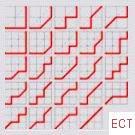
The Fingerprint of a Triangle
-
Triangles
- T01 Pascal-Triangle
- T02 Worpitzky-Triangle
- T03 Faulhaber-Hurwitz-Triangle
- T04 Clausen-Numbers
- T05 Euler-Secant-Triangle
- T06 Euler-Tangent-Triangle
- T07 Euler-Triangle
- T08 Polygonal-Numbers
- T09 Deco-Polyomino-Triangle
- T10 Standard-Tableaux
- T11 Catalan-Narayana-Triangle
- T12 Eulerian-Number
- T13 Pierce-Bell-Triangle
- T14 MacMahon-Triangle
- T15 Crete-Polynomials
- T16 Generalized-Variations
-
Pages
- Home
- Introduction
- Triangle Definitions
- Fingerprint of a Triangle
- Glossary
Given a function T : (n, k) → T(n, k)
Triangle := proc(T, len) local k, n;
seq(print(seq(T(n,k), k=0..n)), n = 0..len) end;
Note in particular that the offset is (0,0) for all triangles!
| T(0,0) | ||||||
| T(1,0) | T(1,1) | |||||
| T(2,0) | T(2,1) | T(2,2) | ||||
| T(3,0) | T(3,1) | T(3,2) | T(3,3) | |||
| T(4,0) | T(4,1) | T(4,2) | T(4,3) | T(4,4) | ||
| T(5,0) | T(5,1) | T(5,2) | T(5,3) | T(5,4) | T(5,5) | |
| T(6,0) | T(6,1) | T(6,2) | T(6,3) | T(6,4) | T(6,5) | T(6,6) |
FlippedTriangle := proc(T, len)
local k, n;
seq(print(seq(T(n,n-k), k=0..n)), n = 0..len) end;
| T(0,0) | ||||||
| T(1,1) | T(1,0) | |||||
| T(2,2) | T(2,1) | T(2,0) | ||||
| T(3,3) | T(3,2) | T(3,1) | T(3,0) | |||
| T(4,4) | T(4,3) | T(4,2) | T(4,1) | T(4,0) | ||
| T(5,5) | T(5,4) | T(5,3) | T(5,2) | T(5,1) | T(5,0) | |
| T(6,6) | T(6,5) | T(6,4) | T(6,3) | T(6,2) | T(6,1) | T(6,0) |
| n \ k | 0 | 1 | 2 | 3 | 4 |
| 0 | T(0,0) | T(1,0) | T(2,0) | T(3,0) | T(4,0) |
| 1 | T(1,1) | T(2,1) | T(3,1) | T(4,1) | T(5,1) |
| 2 | T(2,2) | T(3,2) | T(4,2) | T(5,2) | T(6,2) |
| 3 | T(3,3) | T(4,3) | T(5,3) | T(6,3) | T(7,3) |
| 4 | T(4,4) | T(5,4) | T(6,4) | T(7,4) | T(8,4) |
The definitions of the subsequences.
Row(T, m) → seq(T(k + m, m), k = 0 .. len),
starts at T(m,m) for some m.
Row(T, 0) → T(0, 0) T(1, 0) T(2, 0) T(3, 0) T(4, 0)
Row(T, 1) → T(1, 1) T(2, 1) T(3, 1) T(4, 1) T(5, 1)
Row(T, 2) → T(2, 2) T(3, 2) T(4, 2) T(5, 2) T(6, 2)
Row(T, 3) → T(3, 3) T(4, 3) T(5, 3) T(6, 3) T(7, 3)
Row(T, 4) → T(4, 4) T(5, 4) T(6, 4) T(7, 4) T(8, 4)
Col(T, m) → seq(T(k + m , k), k = 0 .. len),
starts at T(m,0) for some m.
Col(T, 0) → T(0, 0) T(1, 1) T(2, 2) T(3, 3) T(4, 4)
Col(T, 1) → T(1, 0) T(2, 1) T(3, 2) T(4, 3) T(5, 4)
Col(T, 2) → T(2, 0) T(3, 1) T(4, 2) T(5, 3) T(6, 4)
Col(T, 3) → T(3, 0) T(4, 1) T(5, 2) T(6, 3) T(7, 4)
Col(T, 4) → T(4, 0) T(5, 1) T(6, 2) T(7, 3) T(8, 4)
RowDiag(T, m) → seq(T(2*k + m, m + k),
k = 0 .. len),
starts at T(m,m) for some m.
RowDiag(T, 0) → T(0, 0) T(2, 1) T(4, 2) T(6, 3) T(8, 4)
RowDiag(T, 1) → T(1, 1) T(3, 2) T(5, 3) T(7, 4) T(9, 5)
RowDiag(T, 2) → T(2, 2) T(4, 3) T(6, 4) T(8, 5) T(10, 6)
RowDiag(T, 3) → T(3, 3) T(5, 4) T(7, 5) T(9, 6) T(11, 7)
RowDiag(T, 4) → T(4, 4) T(6, 5) T(8, 6) T(10,7) T(12, 8)
ColDiag(T, m), → seq(T(2*k + m, k), k =
0 .. len),
starts at T(m,0) for some m.
ColDiag(T, 0) → T(0, 0) T(2, 1) T(4, 2) T(6, 3) T(8, 4)
ColDiag(T, 1) → T(1, 0) T(3, 1) T(5, 2) T(7, 3) T(9, 4)
ColDiag(T, 2) → T(2, 0) T(4, 1) T(6, 2) T(8, 3) T(10, 4)
ColDiag(T, 3) → T(3, 0) T(5, 1) T(7, 2) T(9, 3) T(11, 4)
ColDiag(T, 4) → T(4, 0) T(6, 1) T(8, 2) T(10,3) T(12, 4)
The definitions of some characteristics.
Note that we take the absolute values of the members of the triangle.
SUM(T, n) → add(abs(T(n, k)),k=0..n); ALS(T, n) → abs(add((-1)^k*abs(T(n, k)),k=0..n));
Calculating the lcm and the gcd of the rows of the triangle we want to exclude 0 and 1 most of the time. Therefore we use the following algorithm.
- Z = Z setminus {-1,0,1}.
- If Z = {} (empty set) then Z = {1}.
- Now compute lcm Z and gcd Z as usual.
In some cases other algorithms might be better suited.
LCMGCD := proc(T, len, U) local n,k,L,S,R,Z,C;
S:= [];
for n from 0 to len do
Z := {seq(T(n,k),k=0..n)};
Z := Z minus {-1,0,1};
if Z = {} then Z := {1} fi;
L := `if`(U=0,ilcm(op(Z)),igcd(op(Z)));
S := [op(S), L];
od; S end:
LCM := (T,len) -> LCMGCD(T,len,0):
GCD := (T,len) -> LCMGCD(T,len,1):
ECT